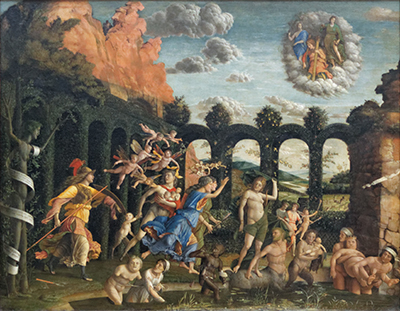Triumph of the Virtues, an artwork by Andrea Mantegna who was executed in the year 1502, is one of the most outstanding works by this particular artist. This painting can be seen in Musée du Louvre, a house in Paris.
This picture came as the second painting for Isabella d'Este's studiolo by Mantegna. This was preceded by the Parnassus of 1497. It shows a tall fence that encloses a marsh. In the triumph of the vices, it is clear that the vices have an upper hand in ruling the enclosure. There is evidence of hideous figures that are the vices ruling the fence. These hideous figures as portrayed can only be medieval. This is because there are scrolls that were prevalent in medieval times. Diana is portrayed as being rescued by Minerva, who in essence is seen chasing idleness. Diana being the goddess of chastity must not be raped as a Centaur, a symbol that is associated with concupiscence, is seen trying to do.
There is a tree that has human virtues just beside Minerva with Justice, Temperance and Fortitude above it; the theological virtues. These are the moral values that are considered as core and primary in the life of any human being. This work is done in a tactical way, ensuring that emotions are elicited as intended. There is a deliberate move to show the vices that were trying to invade the garden of virtues. These vices are seen being chased from the garden as is evident in the triumph of the virtues. This is not an easy task since the vices have control of the garden as they rule it. It will require Minerva to exert real effort to ensure that the battle is won. Without proper effort, it will not be possible to defeat the vices.
As you keenly look at the triumph of the virtues, it is evident that vices can never prevail over virtues if there is a willingness to expel them. The vices are seen as being chased from the garden. Traditional art has frequently delivered moral guidance, be it either through the depiction of religious themes or even perhaps directly matching the artist's own feelings. Religion would dominate art for many centuries, partly because these institutions would be amongst the richest groups in Europe, allowing them to call on the services of the finest artists available. There was also a huge influence from religion within society, much more so than today within the west, and so it was pretty much impossible to avoid some of these themes whislt working as a painter or sculptor during the 15th and 16th century.




